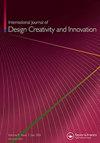设计创意与设计工作室对话的语义分析
IF 2.5
Q4 ENGINEERING, MANUFACTURING
International Journal of Design Creativity and Innovation
Pub Date : 2020-12-01
DOI:10.1080/21650349.2020.1838331
引用次数: 11
摘要
摘要对设计活动中的对话进行分析,有助于深入了解设计思维及其与创造力的关系。采用语义分析的方法来探究学生和教师之间交流和信息交流的语义内容。目标是从抽象、多义、信息内容和语义相似性度量的角度来检查设计对话,并分析它们与最终解决方案创造力的关系。这些设计成果是根据其独创性、可用性、可行性、整体价值和整体创造力进行评估的。因此,对来自第十届设计思维研究研讨会(DTRS10)数据集的35次设计对话进行了分析。主要结果表明,信息内容和语义相似性预测创意,信息内容单独预测整体创意。同样,抽象预测可行性,而语义相似性、信息内容和多义预测总体价值。在教师的语境中,语义相似性预测了可用性,多义预测了可行性。对于学生来说,语义相似性预测了整体价值。总的来说,语义相似性和信息内容是最丰富的衡量标准,因此可以考虑在设计工作室中促进创造力。还讨论了使用自动化系统等支持工具的含义。本文章由计算机程序翻译,如有差异,请以英文原文为准。
Design creativity and the semantic analysis of conversations in the design studio
ABSTRACT The analysis of conversations during design activity can facilitate deeper insights into design thinking and its relation to creativity. A semantic analysis approach was employed to explore the semantic content of communication and information exchange between students and instructors. The goal was to examine design conversations in terms of abstraction, Polysemy, Information Content, and Semantic Similarity measures, and analyze their relation to the creativity of final solutions. These design outcomes were assessed according to their Originality, Usability, Feasibility, Overall Value, and Overall Creativity. Consequently, 35 design conversations from the 10th Design Thinking Research Symposium (DTRS10) dataset were analyzed. The main results showed that Information Content and Semantic Similarity predicted Originality, and Information Content alone predicted Overall Creativity. Likewise, Abstraction predicted Feasibility, while Semantic Similarity, Information Content, and Polysemy predicted Overall Value. In context of instructors, Semantic Similarity predicted Usability, and Polysemy predicted Feasibility. For students, Semantic Similarity predicted Overall Value. On the whole, Semantic Similarity and Information Content were the most prolific measures, and therefore could be considered for promoting creativity in the design studio. The implications of using support tools such as automated systems are also discussed.
求助全文
通过发布文献求助,成功后即可免费获取论文全文。
去求助
来源期刊

International Journal of Design Creativity and Innovation
ENGINEERING, MANUFACTURING-
CiteScore
3.80
自引率
27.80%
发文量
15
期刊介绍:
The International Journal of Design Creativity and Innovation is an international publication that provides a forum for discussing the nature and potential of creativity and innovation in design from both theoretical and practical perspectives. Design creativity and innovation is truly an interdisciplinary academic research field that will interest and stimulate researchers of engineering design, industrial design, architecture, art, and similar areas. The journal aims to not only promote existing research disciplines but also pioneer a new one that lies in the intermediate area between the domains of systems engineering, information technology, computer science, social science, artificial intelligence, cognitive science, psychology, philosophy, linguistics, and related fields. The journal covers, but is not restricted to, the following topics: ·Theories on Design Creativity and Innovation ·Cognition of Design Creativity ·Innovative Process ·Inventive Process ·Analogical Reasoning for Design Creativity and Innovation ·Design Synthesis ·Method and Tools for Design Creativity and Innovation ·Representation of Design Creativity and Innovation ·Education for Design Creativity and Innovation ·Concept Generation and Inspiration.
 求助内容:
求助内容: 应助结果提醒方式:
应助结果提醒方式:


